Growing potatoes: preparation of tubers and planting methods
Potato Is the most important vegetable in the backyard. Gardeners diligently cultivate crops so that it will depend on whether the family stays with the harvest for the winter or not. There are many ways to breed valuable potatoes. The process of preparing planting material and planting depends on the region and plant variety. Therefore, it is necessary to approach the cultivation technology adequately, according to the climatic zone and the type of soil. The potato variety is also selected based on these factors. The gardener will learn about all the nuances of preparation, planting and growing from this useful material.
Content
- Choosing the best variety for planting
- Cooking tubers for planting: germination methods
- Choosing a site for potatoes
- Landing rules and methods
Choosing the best variety for planting
For a successful choice of a variety, the gardener needs to take into account the ripening time of the tubers, the region and the type of soil. The first criterion is considered one of the most important. Average ripening time potatoes is 80-90 days. Despite the fact that many varieties claim a shorter period, the plant will need at least 80 days to develop - this has already been tested by experienced potato growers.
Based on climatic conditions, a potato variety is selected. Allocate:
- Early ripe - ripening periods are up to 80 days
- Mid-season - ripening time up to 100 days
- Late ripening - ripening period up to 140 days
Early ripening potatoes are preferred by those who like to taste fresh potatoes in the summer, not in the fall. For storage vegetable in winter, it is recommended to breed late-ripening varieties. In Siberia, for example, it is inappropriate to plant late species, since they simply do not have time to ripen. Summer in these regions is short, cold comes early.
Therefore, consider the place where you are going to grow potatoes.
For cultivation of a crop in a personal plot, you should choose table varieties, and not fodder or technical ones. Depending on the type of soil, the following are the best potato varieties:
- "Luck" is an early ripening variety, the yield of which reaches 800 kg per one hundred square meters. The flesh of the tuber is white, the taste is average. The variety is resistant to many diseases potato - late blight, rot, mosaic virus. Suitable for all types of soils.
- "Zhukovsky" is an early ripening variety suitable for all types of soil. Tubers are pink with white flesh, good taste. From 100 m? collect up to 500 kg. Disease and drought resistant.
- "Romano" is a mid-season variety that can grow in any soil. The tubers are pinkish, the flesh is white. Potato yield reaches 350 kg per one hundred square meters. Disease resistant and pests... Reacts poorly to drought. Stores well in winter.
- "Bezhitskiy" is a mid-season variety that loves light soils. The tubers are red, the flesh is white, the taste is good. The yield per one hundred square meters is up to 500 kg. Drought tolerant, disease resistant. Stores well in winter.
- "Lugovskoy" is a mid-season variety, the yield of which is up to 500 kg per one hundred square meters. Tubers are pinkish with white flesh. Resistant to diseases and pests. Stores well in winter.
- "Belorussky 3" is a late-ripening variety with excellent taste. The tuber is white, smooth.Productivity from 100 m? reaches 600 kg. Stores well in winter. Disease resistant.
- "Aspia" is a mid-season variety, suitable for growing in loamy soils. The yield reaches 450 kg per one hundred square meters. Tubers are white, taste good. Stores well in winter.
- "Latona" is an early ripening variety that gives a good yield in fertile soil up to 600 kg from 100 m ?. The tuber is yellowish, the flesh is light yellow. Resistant to many diseases. Stores well in winter.
- "Nevsky" is an early ripening variety that takes root well in any region and soil. The yield of potatoes is up to 500 kg from 100m?. Tubers are white, taste good. The variety is resistant to many diseases typical of potatoes. Stores well in winter. "Nevsky" is considered one of the most popular varieties, it adapts to any soil and always gives a bountiful harvest.
Every gardener has his favorite vegetable variety and never part with it. However, plant species should be changed every 5-6 years. By planting the same variety, the gardener runs the risk of one day getting a bad crop, which will be poorly stored and quickly rot. It means that the time has come to change the planting material to a new one, to withdraw the old one.
Cooking tubers for planting: germination methods
The preparation of tubers for planting means them germination... Why is this done? If you just get the seed material from the basement and scatter it over the holes, it will take three weeks more for the plant to develop than it did with preparation. In some regions of the country, this is an unaffordable luxury. Nobody wants to waste almost a month of precious time. Therefore, it is more advisable to prepare seed material and harvest on time.
There are several methods for preparing potatoes. There are three most effective and common ways:
- "Light". It is considered a simple and effective method of sprouting tuber sprouts. Seed material is taken out of the basement to a bright and warm place. It is laid out in one layer. The room temperature should be 20 ° -22 °. The potatoes should be well lit with natural sunlight, but don't put them out in the sun. When laying out material, sort out ugly and diseased tubers. Nothing will grow out of them anyway. Potato begins to germinate in about 10-15 days. Consider this when planning outdoor planting.
- "Greenhouse". This method of germination involves the use of plastic bags. Small holes are made in them for ventilation. The sacks are filled with seed about a third of the sack. The polyethylene is closed and hung in a bright, warm place. A greenhouse effect is obtained in the bag, the tubers germinate quickly. It will take 10 days to prepare in this way. In the same bags, you can transport potatoes to your personal plot.
- "Watering". This method is considered the most unusual but effective. It is designed for those who do not have the time and opportunity to wait several weeks for germination material. The day before planting, the seed is filled with water. One day the potatoes lie in the rain, warm water. Then proceed to planting. So the material will germinate faster in the soil, the process will only take a couple of weeks for the seedlings to ripen in the soil.
Many growers cut large tubers before planting. This is a good way to increase the amount of seed. But you need to do it right. After cutting the tuber, sprinkle the cuts with ash. The cut potatoes should stand in the fresh air for one to two days. Only then can it be planted in open ground.
Try to cut the tubers so that there are eyes on both halves.
Don't forget about planting potatoes. Small seed material, potatoes weighing less than 30 g, will give a poor harvest. Choose medium-sized tubers - from 30 g to 80 g. Large, cut material produces a bountiful harvest than small "peas". They are discarded.Seed material is ready, sprouts have already formed on it - it's time for site selection and planting.
Choosing a site for potatoes
Potatoes unpretentious to the soil. It can grow successfully both in black soil and in loamy, sandy soil. Almost all varieties of vegetables respond well to fertilizers - humus, minerals and complexes. Try to choose flat, well-lit areas for potatoes. They should not be shaded by trees or houses.
If the surface of the plot is uneven and there is a risk of water accumulation in the aisles, make good drainage.
Apply fertilizer to the soil in advance. The field for potatoes should be plowed and removed weeds... Many gardeners add wood ash to each hole or trench - a measure that prevents tuber diseases and promotes their rapid growth.
An important point when planting a vegetable is not only soil preparation, but also a good choice of planting dates. The yield and quality of potatoes will depend on this.
Rules and methods of planting potatoes
Planting dates depend on the region and the selected variety. But there is one common natural landmark that signals landing - this is Birch and bird cherry... As soon as the birch leaves have turned green, the bird cherry has faded, tubers can be planted. Experienced gardeners usually wait a couple of weeks after the birch leaves have blossomed.
Why birch? The fact is that it turns green only when the soil warms up to 8 ° -10 °. This is the indicator that is necessary for the growth of tubers in the open field. It usually takes 90 days for a vegetable to ripen. Build on these deadlines. That is, landing is often planned for mid-May.
The way potatoes are planted is of great importance.
The yield will depend on this. The method is chosen depending on the type of soil. There are several ways to plant potatoes... Experienced gardeners take into account soil type, site topography and region. Depending on these factors, the landing method is chosen:
- "Flat" fit. The "flat" method means planting tubers in a hole, which is covered with soil without a bump. This is the most common and easiest planting method. It is intended for flat, sunny areas with good climatic conditions. If the field is bumpy, with large differences, this method is not suitable. Water will constantly accumulate in certain places. This can provoke rot of tubers, the harvest will be poor. The holes are dug out small - 8 cm. Using a shovel, lift the soil and plant the tuber sprouts up. It is advisable to add one or two teaspoons of ash to the hole. It contains the necessary and useful elements for plant growth.
- "Crest". This method is significantly different from the first. It is intended for those regions where there is almost always a threat of cold snap, flooding, air and soil temperatures are low - regions of Siberia. The holes are dug out shallow - up to 5 cm.The complex is introduced into them mineral fertilizers... The potato hole is covered with soil. As the plant grows gradually hilling... That is, whenever sprouts appear above the surface, they are covered with earth. This is done until a high ridge is formed. Its height can reach 15 cm. Why is this done? The fact is that the root system, with constant hilling and raising of the earth, automatically moves higher. That is, the risk of overcooling the tubers and their heating is reduced, since they are always above the soil level. The comb heats up quickly and keeps it warm for a long time. This method is suitable for regions with unfavorable climatic conditions, when there is a risk of crop loss.
- "Trench". This method is used in regions where sandy or peaty soil predominates. Potatoes in such soil have a hard time, as they constantly lack moisture. In this regard, they resort to a planting method called "trench".A ditch is dug up to a depth of 10 cm. fertilizers, the soil is thoroughly spilled with rainwater. Tubers are planted sprouting upwards at a foot distance from each other. A distance is left between the trenches so that you can move freely, take care of the plants. The moat is covered with soil. The surface is carefully spilled and closed mulch - cut grass, straw. So the soil will keep moisture for a long time, sufficient for the ripening of the crop. If the soil is too light and the region is dry, this planting method is recommended. Always consider soil type and region before planting seed. Choose a planting method according to the plant's requirements - moisture and warmth.
There are other unusual planting methods. potatoes - in barrels, containers and other containers. But the most successful will always be planting the material in open ground, in a tree-free area, sunny and warm. Depending on the variety chosen, planting method and care, the gardener will harvest. With proper planning and preparation of seed material, yields will be at their best!
More information can be found in the video.



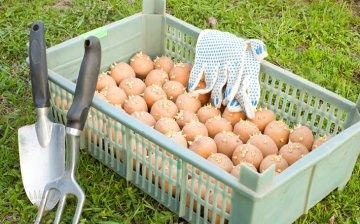
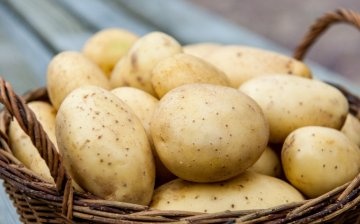
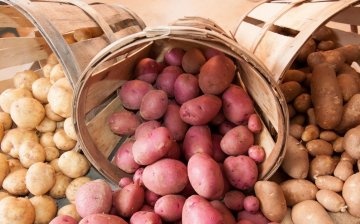
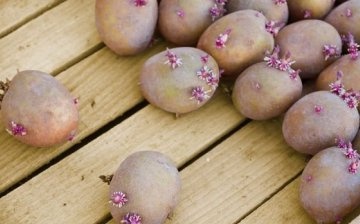


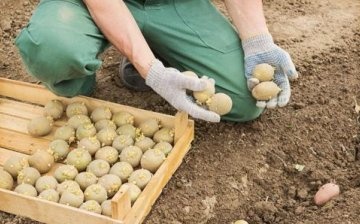







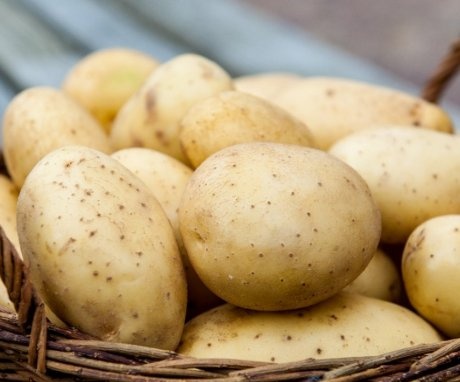
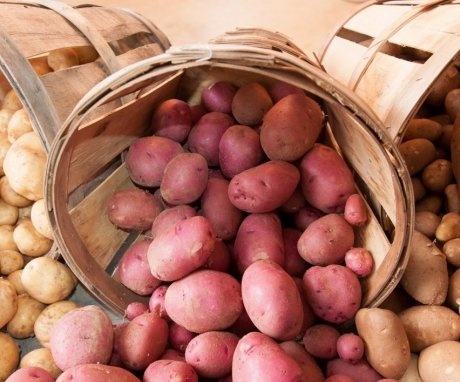
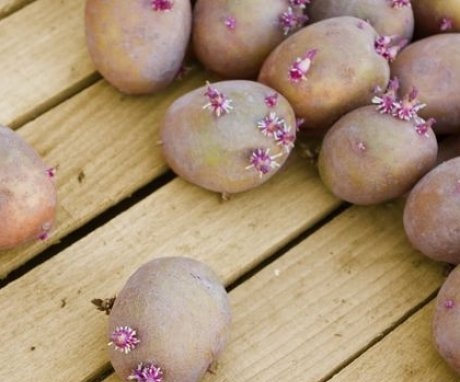
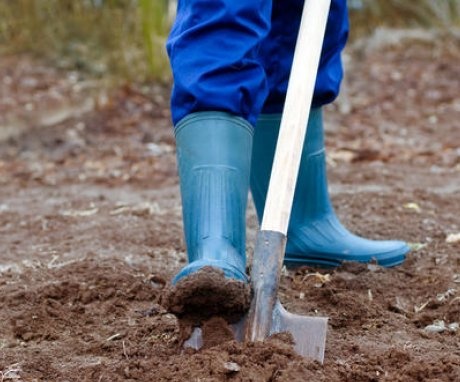

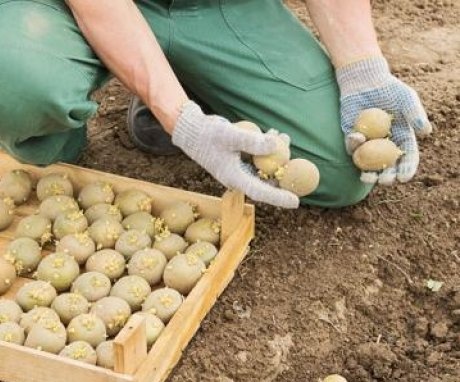
We always germinate planting potatoes, however, we plant not large, but medium, or slightly smaller than average in size. This year I will try to fill the planting material with water for a day - this greatly saves time on preparation.